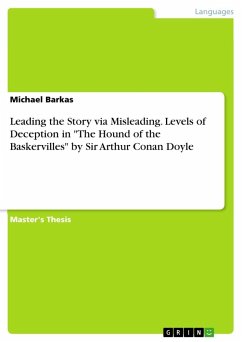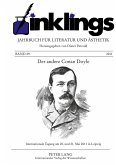Master's Thesis from the year 2017 in the subject Didactics for the subject English - Literature, Works, grade: 1,3, University of Bonn (Anglistik, Amerikanistik und Keltologie), language: English, abstract: The introductory chapter provides a brief retrospection of the "Sherlock Holmes phenomenon" in Doyle's times and in our days. It also offers some important background information on the rise of detective-mystery stories and the socio-political circumstances that necessitated the emergence of a figure like Holmes in the literary scene. Chapter 2 elaborates on three different levels of deception in "The Hound of the Baskervilles". On one occasion, deception can be said to be synonymous to superstition because it results from lack of observation or sufficient scientific knowledge in order to explain the inexplicable. This type of deception is classified as such due to the constantly advancing scientific achievements, the questioning and decline of Christian faith during the Victorian era, the triumph of rationality over superstition and the more systematic examination of various peculiar phenomena. To a certain degree, Doyle represents all these because he is a man of science and knows how to "enlighten" or teach the public of his times by using scientific insights and some far-fetched observations and deductions which are performed by his hero. On another occasion, deception is bound to Watson's narrating style. Finally, the third and most explicit type is part of the story's plot. Holmes, on the one hand, lies to Watson and deceives him in order to confront the upcoming danger in utmost secrecy. There is no evil intention here. On the other hand, Jack Stapleton, who represents an impious fraud and wants to gain for his own sake deceives in order to fulfil his crime. His evil intentions render him the main source of deception by means of disguising himself, his wife and his hound so that they look much different than what they are in reality. Finally, chapter 3 provides some thoughts and conclusions about reading pleasure and reader expectations, but also some critical "rules" that pertain to the reader's involvement in the story. Those "rules" of the later Golden Age of detective fiction were proposed by famous authors, mainly Father Ronald Knox, Raymond Chandler and S. S. Vine, who talked about 'honesty' to the reader, various aesthetic values and the chance to enable a parallel solving of the mystery along with the detective. Nevertheless, a recent approach to this puzzle-solving aspect shows how impossible it is to solve Conan Doyle's mysteries by following certain clues and to arrive at fixed solutions. Examples are offered.
Hinweis: Dieser Artikel kann nur an eine deutsche Lieferadresse ausgeliefert werden.
Hinweis: Dieser Artikel kann nur an eine deutsche Lieferadresse ausgeliefert werden.








